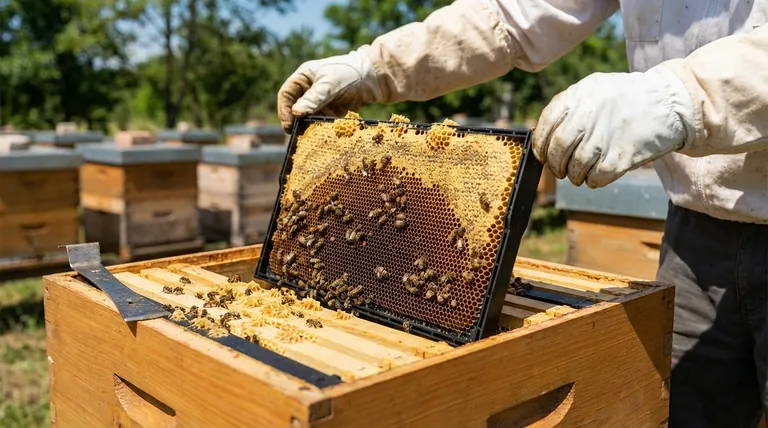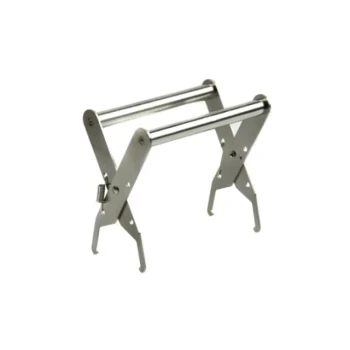At its core, a beehive frame serves one primary purpose: to provide a structured, removable foundation for bees to build their honeycomb. This simple wooden or plastic rectangle transforms the hive from a chaotic, fixed structure into an organized and manageable system for the beekeeper. Frames guide the bees' construction, allowing for easy inspection, management, and honey harvesting without destroying the colony.
The removable frame is the single most important invention in modern beekeeping. It allows beekeepers to work with the bees as stewards, rather than simply raiding the hive for honey, fundamentally enabling the practice of sustainable apiculture.

The Core Problem: A Hive Without Structure
Before the widespread adoption of removable frames, beekeeping was a far more destructive and inefficient process. Understanding this context reveals why frames are so revolutionary.
The Destructive Past
Historically, bees were often kept in simple containers like hollow logs or straw baskets called "skeps." Harvesting honey from these hives required cutting out the comb, a process that inevitably destroyed the colony's home and often the colony itself.
The Need for Order and Inspection
A beekeeper cannot manage what they cannot see. Without frames, inspecting the health of the queen, checking for disease, or assessing food stores was nearly impossible. The internal state of the hive was a complete mystery until it was torn apart.
How Frames Create an Organized System
The modern Langstroth hive is built entirely around the concept of the removable frame. This design solves the historical problems by imposing a predictable order that benefits both the bees and their keeper.
A Blueprint for Building
Frames hold a sheet of foundation, which is typically a thin sheet of beeswax or plastic embossed with a honeycomb pattern. This gives the bees a clear guide, encouraging them to build straight, even comb within the confines of the frame.
This predictable structure is essential for creating the uniform "bee space" between combs that prevents bees from sealing the entire hive together with rogue wax.
Enabling Non-Destructive Management
The ability to lift a single frame out of the hive is a game-changer. A beekeeper can gently remove a frame to check the brood pattern (the queen's egg-laying), look for signs of pests or disease, and see how much honey and pollen are stored.
This allows for early intervention on health issues and a clear understanding of the colony's strength and needs.
Facilitating Hive Expansion and Health
Frames give the beekeeper precise control over the hive's internal space. As a colony grows, the beekeeper can add empty frames to provide more room for the queen to lay eggs and for workers to store honey.
Conversely, frames can be rearranged or removed to improve airflow during hot weather or to configure the hive for winter.
Simplifying the Honey Harvest
When it's time to harvest, the beekeeper can simply remove the frames that are full of capped honey. This process is efficient and causes minimal disruption to the rest of the hive, leaving the brood nest and the colony's structure intact.
Understanding the Trade-offs and Considerations
While frames are essential, their effective use depends on understanding the principles behind their design.
Respecting "Bee Space"
The entire system relies on maintaining a specific gap—about 3/8 of an inch—between each frame and between the frames and the hive walls. If the space is too large, bees will build rogue comb in the gap; if it's too small, they will seal it with propolis (a resinous "bee glue").
Properly built hives and frames automatically maintain this critical spacing.
Frame Types and Materials
Frames come in various sizes to fit different hive boxes (deep, medium, and shallow) and can be made of wood or plastic. Some beekeepers prefer foundationless frames to allow bees to build more natural comb, though this requires more careful management to prevent cross-combing.
The choice of material and foundation type is a matter of beekeeping philosophy and operational preference.
Making the Right Choice for Your Goal
The use of frames directly supports the primary goals of any beekeeper.
- If your primary focus is hive health: Frames are your window into the colony, allowing you to monitor the queen's performance and catch signs of disease before they become catastrophic.
- If your primary focus is honey production: Frames create an organized, repeatable system for bees to store honey, making your harvest clean, efficient, and sustainable.
- If your primary focus is colony growth: Frames give you the tools to strategically manage space, encouraging population growth and preventing swarming.
Ultimately, frames transform a beehive from a simple box into a living, manageable filing cabinet of resources, brood, and honey.
Summary Table:
| Function | Benefit |
|---|---|
| Provides Foundation | Guides bees to build straight, manageable comb. |
| Enables Inspection | Allows beekeepers to check queen health and disease. |
| Facilitates Harvesting | Makes honey extraction clean and efficient. |
| Supports Hive Health | Gives control over space for colony growth and ventilation. |
Ready to build a more productive and healthy apiary?
As a leading wholesale supplier to commercial apiaries and distributors, HONESTBEE provides the durable, precision-made frames and beekeeping equipment your operation depends on. Our products are designed to support sustainable, large-scale beekeeping by enabling efficient hive management and maximizing honey production.
Contact our expert team today to discuss your wholesale needs and discover how our equipment can strengthen your bottom line.
Visual Guide

Related Products
- Plastic Bee Frame Beekeeping Hive Frames for Wholesale
- Assembled Wooden Bee Frames with Beeswax Foundation Ready to Use by HONESTBEE
- HONESTBEE Wired and Assembled Wooden Bee Frames Foundation for a Thriving Hive
- Assembled Wooden Bee Frames with Plastic Foundation for Durability and Convenience by HONESTBEE
- Durable Rubberized Comfort Handle Frame Grip
People Also Ask
- What is the role of oxalic acid in plants? A Key to Plant Defense and Internal Regulation
- What are the differences between wooden and plastic frames in beehives? Choose the Best for Your Apiary
- Why are plastic frames popular in commercial beekeeping? Boost Efficiency & Durability at Scale
- Are plastic bee hive frames good? A Guide to Modern Durability vs. Natural Appeal
- What are the main types of frames available for beehives? Wood vs. Plastic for Your Apiary



















